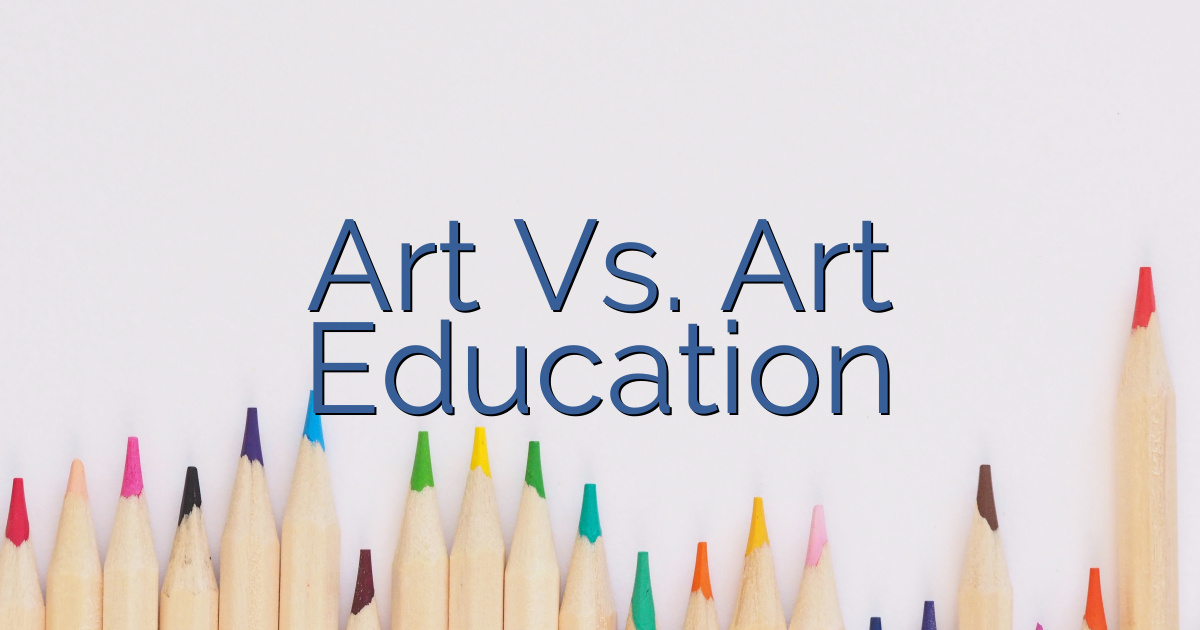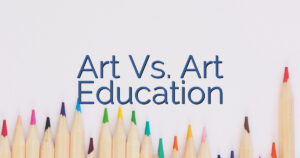 Do you have a passion for art, but are torn between pursuing a career as a fine artist or becoming an art educator?
Well, look no further! In this article, we will delve into the world of art versus art education, providing you with an in-depth comparison of these two majors.
From the curriculum and teaching methods to the skills developed and career opportunities, we’ve got you covered.
So, grab your paintbrush or your lesson plans, and let’s dive into the world of art and art education!
Do you have a passion for art, but are torn between pursuing a career as a fine artist or becoming an art educator?
Well, look no further! In this article, we will delve into the world of art versus art education, providing you with an in-depth comparison of these two majors.
From the curriculum and teaching methods to the skills developed and career opportunities, we’ve got you covered.
So, grab your paintbrush or your lesson plans, and let’s dive into the world of art and art education!
Table of Contents
Key Takeaways
- Fine Art focuses on personal style and creative expression, while Art Education emphasizes teaching and nurturing artistic skills in others.
- Both majors offer flexibility in coursework to tailor studies to specific interests and goals.
- Art Education majors have more stable job prospects due to the constant demand for qualified art teachers in schools and community centers.
- Fine artists can work independently or collaborate with others, while art educators can find opportunities in various settings such as schools, community centers, or by starting their own art classes.
Overview of the two majors: Fine Art and Art Education
If you’re considering a major in art, it’s important to understand the differences between Fine Art and Art Education. Fine art focuses on the creation and expression of art for aesthetic purposes. It encompasses various mediums such as painting, sculpture, and photography. On the other hand, Art Education emphasizes the teaching and nurturing of artistic skills and knowledge in others. It involves learning how to effectively teach art to students of different age groups and backgrounds. While both paths involve a passion for art, they offer distinct career opportunities. If you have a strong desire to create art and showcase your personal style, pursuing a career in Fine Art may be the right choice for you. On the other hand, if you have a passion for teaching and inspiring others through art, Art Education could be the ideal path. Exploring the benefits of pursuing a career in art education, you will have the opportunity to make a lasting impact on students’ lives, foster their creativity, and cultivate a love for art. Additionally, art educators often have stable job prospects, as there is a constant demand for qualified teachers. Consider your strengths, interests, and long-term goals to determine which path aligns better with your aspirations.Overview of the curriculum and requirements of the two majors
To understand the curriculum and requirements of each major, you should take a closer look at the courses and prerequisites for both art and art education. In terms of studio practice, the art major focuses on developing technical skills and exploring various artistic mediums. Students are encouraged to experiment, take risks, and push the boundaries of their creativity. On the other hand, the art education major incorporates a combination of studio practice and educational theory. In addition to honing their artistic skills, art education students learn about pedagogy, curriculum development, and classroom management. They also gain a deeper understanding of how to integrate art into the larger educational context. While both majors emphasize the importance of artistic expression, they differ in their approach to the creative process and the role of art in education.Overview of coursework, assessments, and teaching methods
The coursework for both majors includes a combination of studio practice and educational theory. This allows you to develop your artistic skills while also learning how to effectively teach others. The coursework flexibility in both art and art education majors allows you to tailor your studies to your specific interests and goals. In the art major, you will engage in a variety of studio classes that focus on different mediums and techniques. This hands-on experience will help you refine your artistic abilities and explore your creative potential. On the other hand, the art education major will provide you with a solid foundation in teaching techniques. You will learn how to design lesson plans, manage a classroom, and engage students through art. Overall, the coursework in both majors provides a well-rounded education that combines artistic practice with the knowledge and skills needed to be an effective art educator.Comparison of Skills Developed: Creativity and Critical Thinking
Both majors develop skills in creativity and critical thinking. In art, creativity is key as artists use their imagination to create unique and innovative works. They explore different mediums, experiment with techniques, and push boundaries to express their ideas. On the other hand, art education focuses on developing critical thinking skills. Educators interpret artworks, analyze their historical and cultural context, and encourage students to think critically about artistic choices. Problem-solving is crucial in art, as artists often face challenges and obstacles that require creative solutions. Interpretation plays a significant role in art education, where students learn to analyze and understand artworks from various perspectives. Both majors cultivate these skills, but in different ways, highlighting the importance of both creativity and analysis in the art world.Comparison of Career Opportunities and Job Roles: Graphic Design
Explore the wide range of career opportunities available in graphic design, where you can apply your creative skills to design logos, websites, and other visual elements for businesses and organizations. Graphic design is a rapidly growing field with high industry demand, offering great potential for career growth. Here are three key job roles in graphic design:- Graphic Designer: As a graphic designer, you will use your artistic abilities to create visual concepts and communicate ideas through various mediums. You will collaborate with clients and colleagues to develop designs that effectively convey messages.
- Art Director: In this role, you will oversee the creative process, managing a team of designers and ensuring that visual elements align with the overall brand and objectives. Art directors also have a hand in developing concepts and making decisions regarding design direction.
- UX/UI Designer: User experience (UX) and user interface (UI) designers focus on improving the usability and visual appeal of digital products. These professionals create intuitive interfaces, wireframes, and prototypes, enhancing user satisfaction and engagement.
Comparison of Salary Potential: Job Market
Consider the salary potential in the job market for graphic designers, where your creative skills and expertise can lead to competitive compensation and financial growth. In today’s digital age, graphic design plays a crucial role in various industries, resulting in a high demand for skilled professionals. As a graphic designer, you have the opportunity to earn a lucrative income. The average salary for graphic designers in the United States is around $52,000 per year, with the top 10% earning over $87,000 annually. Job satisfaction is another significant factor in this field, as graphic designers often have the freedom to express their creativity and work on diverse projects. Moreover, job security is generally stable for graphic designers, as companies of all sizes require their services for branding, marketing, and web design. With the right skills and experience, you can enjoy a fulfilling career as a graphic designer, both financially and professionally.Similarities between Fine Art and Art Education Careers
Now that we have compared the salary potential and job market for both fine art and art education careers, let’s explore the similarities between these two career paths. Despite their differences, there are some commonalities that can be found in both fields.- Creativity: Both fine artists and art educators rely on their creativity to excel in their respective roles. Whether it’s creating a masterpiece or designing engaging lesson plans, the ability to think outside the box is crucial.
- Passion for art: A shared love and appreciation for art is a fundamental aspect of both careers. Whether it’s creating art or teaching others about it, a genuine passion for the subject is essential.
- Flexibility: Both career paths offer flexibility in terms of job prospects. Fine artists can choose to work independently, exhibit their work, or collaborate with other artists. Similarly, art educators can find opportunities in schools, community centers, or even start their own art classes.
Difference in job prospects between the two majors
One key difference between the two majors is the variation in job prospects. While both art and art education offer opportunities for creative expression and working with others, the job stability and salary potential differ significantly. In the field of art, job stability can be more uncertain, as many artists work as freelancers or in temporary positions. However, there is potential for high earnings if an artist becomes successful and gains recognition. On the other hand, art education majors have more stable job prospects, as there is a consistent demand for art teachers in schools and community centers. While the salary potential may be lower compared to successful artists, art educators often enjoy a steady income and the fulfillment of teaching and inspiring others.Factors to consider when choosing between art majors
When deciding between art majors, you should think about the specific skills and techniques required in each field. Factors to consider when choosing between art majors include passion and practicality. Passion is important because pursuing a career in a field you’re passionate about can bring you fulfillment and joy. It allows you to express yourself creatively and may lead to greater personal satisfaction. However, practicality is also crucial to consider. Practicality refers to the potential job prospects, salary, and stability of the chosen art major. It’s essential to research the demand for professionals in that particular field and assess the potential for career growth. While passion is vital, it’s essential to strike a balance and consider the practical aspects to ensure a successful and fulfilling career in the art industry.What is the importance of art education in comparison to studying and practicing choreography and dance?
Art education provides a well-rounded approach to creativity, including choreography and dance education, nurturing both physical and emotional intelligence. While studying and practicing choreography and dance is important for skill development, an understanding of broader artistic concepts enhances the depth and interpretation of movement and performance.

